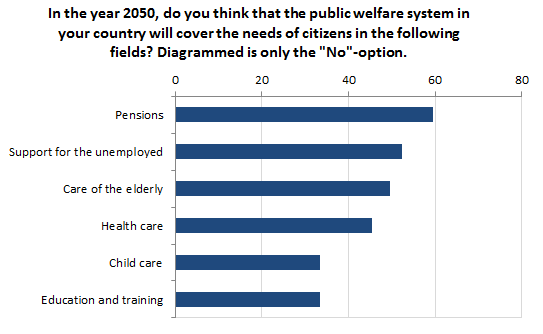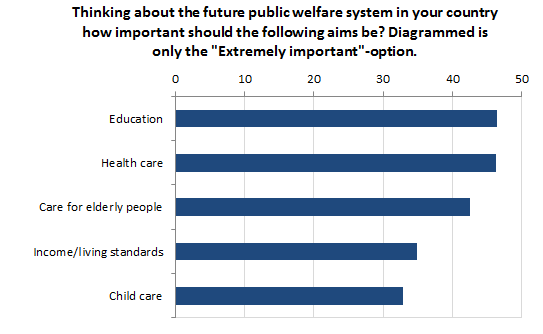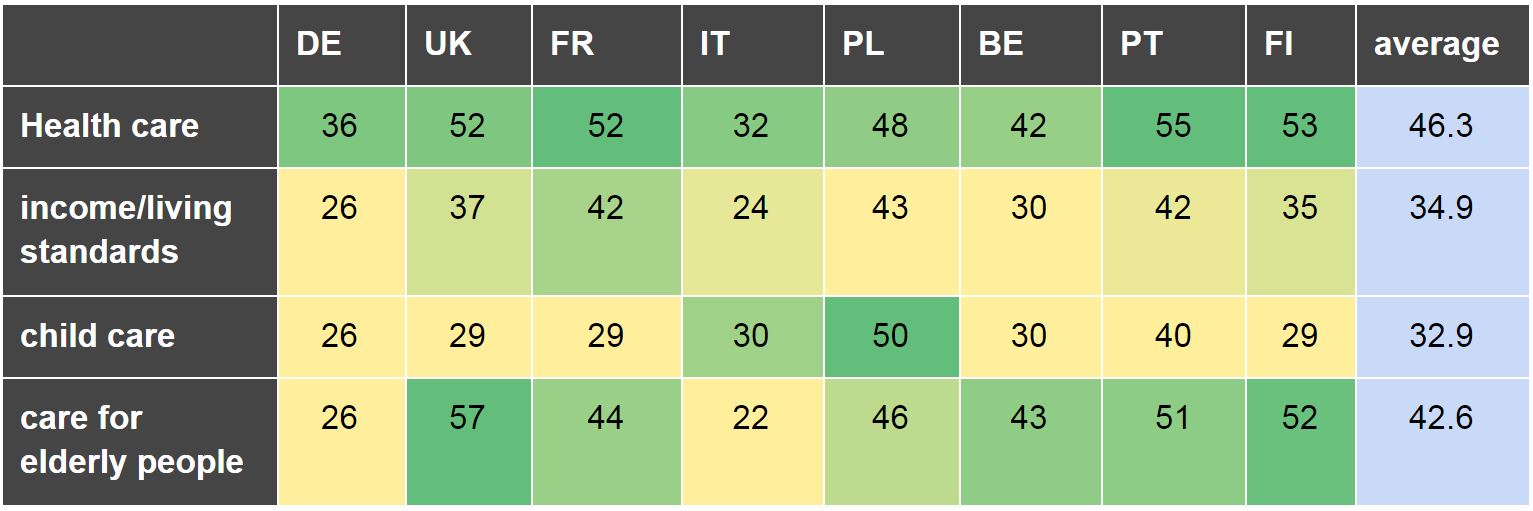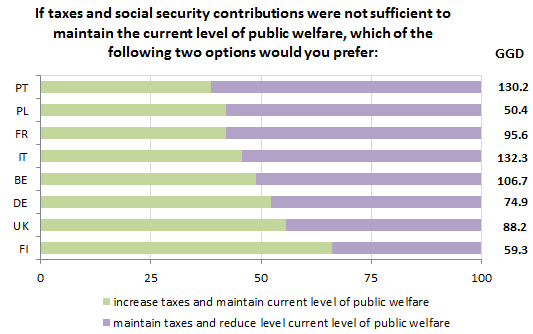What do Europeans think about the future of the welfare state?

This article was originally published by Bruegel, the Brussels-based think tank. Read the article on their website here.
Lack of confidence in the welfare state in the year 2050
Rising EU life expectancy and declining fertility represent major challenges to welfare states in the European Union, in particular with respect to future pension and health systems. The European Commission’s Ageing Report (2015) states that the EU will move from four working-age people per person over 65 today, to about two working-age people in 2040. This will affect both revenue and spending: there will be less revenue because of the shrinking working-age population, and more spending because of higher costs for pensions, health and long-term care.
The survey shows that EU citizens are well aware of these developments: when asked about their confidence in the welfare state in 2050, respondents across the eight countries surveyed feared that the provisions of pensions, as well as care for the elderly, would no longer meet citizens’ needs. Another important fear is the adequacy of unemployment benefits, as well as health care in general.
Figure 1: Lack of confidence in the welfare state in the year 2050
Source: Vision Europe Summit Survey Results: Note: Diagrammed is only the “no”-option in different policy fields as an average across eight countries.
Table 1 reports country-level results and reveals that compared to other countries, German respondents are most worried when it comes to pensions and the care of the elderly in the future, with 70 % of respondents fearing that pensions will no longer meet citizens’ needs and 63 % fearing the same when it comes to care for the elderly. Moreover, 67% of French and 63% of Italian and Polish citizens, are pessimistic about the adequacy of pensions
Another important policy measure questioned by citizens is support for the unemployed in the year 2050. Only in Germany and the United Kingdom did fewer than 50 % of citizens express doubts about adequacy looking ahead. The situation is different in Italy, which is recovering slowly from the recent crisis, and reports that 59% of respondents are pessimistic about unemployment benefits.
Table 1: In the year 2050, do you think that the public welfare system in your country will cover the needs of citizens in the following fields? Answers possible: Yes and No, Diagrammed is only the “No”-option.
Source: Vision Europe Summit Survey Results. Note: The heat-map ranges from yellow to red following the increasing “No”-answers in the single countries. Answers possible: Yes and No, Diagrammed is only the “No”-option.
Orientation of the future welfare state
In recent years, the importance of a ‘social investment’ approach to the welfare state has emerged (see i.e. European Commission), which sees a shift from a ‘compensating’ welfare state to a ‘capacitating’ welfare state, focusing on policies designed to strengthen people’s skills and capacities and support them to participate fully in employment and social life. Investments in early childhood education and training are one of the pillars of social investment. In line with this paradigm shift, 47% of citizens regard education as the most important aim of the welfare state looking ahead (Figure 2). Health as well as care for elderly people follow closely, with respectively 46% and 43% of respondents classifying these two aims as extremely important.Orientation of the future welfare state
Figure 2: Orientation of the future welfare state
Source: Vision Europe Summit Survey Results: Note: Diagrammed is only the “extremely important”-option as an average across eight countries.
On a country level (Table 2), education represents the most important aim in the United Kingdom, Germany, Belgium and Italy, while French and Polish citizens give more or less the same importance to both education and health care. By contrast, respondents in Portugal and Finland find health to be the most important goal looking ahead, as opposed to education. Interestingly, child care gains absolute importance only in Poland.
Table 2: Thinking about the future public welfare system in your country how important should the following aims be? Answers possible: Extremely important, Very important, Somewhat important, Somewhat unimportant, Unimportant. Diagrammed is only the “Extremely important”-option.
Reform options and future financing
As Table 1 shows, across all eight countries citizens question the adequacy of welfare state provision in the future. In this respect, the topic of citizens’ preferences on the nature of future financing is interesting. Figure 3 reports respondents’ preferences, which can be divided into maintaining the current level of public welfare and increase taxes, as opposed to maintaining taxes and reducing the current level of public welfare.
The largest share of citizens advocating the preservation of current benefits can be found in Finland, where 66% support an increase in taxes to maintain current levels of public welfare. A similar picture emerges for the United Kingdom and Germany, where respectively 56 % and 52% of respondents are in favour of increasing taxes. Importantly, these are also countries with levels of public debt between 60 and 90 % of GDP (see right side column in Figure 3), whereas citizens in countries with higher public debt seem to be less in favour of increasing taxes. Indeed, only 46 % of Italian and 39% of Portuguese citizens support an increase in taxes over the reduction of the current level of benefits. Poland is an exception, as people still favour a reduction of current level of public welfare over an increase in taxes, despite a relatively low public debt ratio.
Figure 3: Future financing
Conclusion
Looking ahead, Europe’s citizens are most worried about the adequacy of pensions and care for the elderly. When it comes to future aims of the welfare state, citizens in each of the eight countries surveyed highlight the importance of education, knowledge and skills. And looking at preferences over the future financing of the welfare state, countries with comparatively lower levels of public debt are willing to contribute more in order to maintain the current level of public welfare benefits, while countries with higher levels of public debt prefer cuts in benefits over increases in taxes.
Publication does not imply endorsement of views by the World Economic Forum.
To keep up with the Agenda subscribe to our weekly newsletter.
Author: Pia Hüttl is an affiliate fellow at Bruegel. Guntram Wolff is the Director of Bruegel since June 2013.
Image: A woman looks at a window display on Oxford Street in central London. REUTERS/Olivia Harris.
Don't miss any update on this topic
Create a free account and access your personalized content collection with our latest publications and analyses.
License and Republishing
World Economic Forum articles may be republished in accordance with the Creative Commons Attribution-NonCommercial-NoDerivatives 4.0 International Public License, and in accordance with our Terms of Use.
The views expressed in this article are those of the author alone and not the World Economic Forum.
The Agenda Weekly
A weekly update of the most important issues driving the global agenda
You can unsubscribe at any time using the link in our emails. For more details, review our privacy policy.




